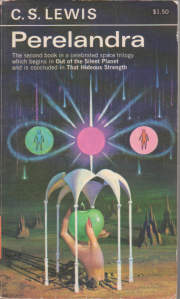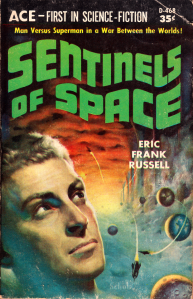The Book: Perelandra by C. S. Lewis. Originally published in 1943, the edition read was published in 1975 by Macmillan Publishing.

The Setting: Venus
The Story: Ransom, hero of Out of the Silent Planet, is sent to Venus to do… something. He encounters a watery world of floating islands with only a very few instances of fixed land. And on them, all manner of spectacular and wonderful things. Not least among these is the green woman who he encounters and who is the first woman on Venus. Ransom and the woman converse. Then Weston, villain of Out of the Silent Plant, shows up. But he’s possessed by the devil. Or a force of evil so pure that it doesn’t really matter what its name is. Anyway, ex-Weston attempts to corrupt the woman by talking to her. A lot. And Ransom, representative of the good forces, tries to counter his arguments. This continues for some time. Then Ransom says, the hell with it, and proceeds to kick the shit out of ex-Weston and get his own shit kicked in the process. They fight across the planet, ending up in a cave where Ransom chokes the ex-Weston. Ransom climbs out of the cave which turns out to be inside a volcano, more or less, and is followed by ex-Weston, who’s not quite dead yet. Ransom disposes of him, finds his way down the mountain, praises God (for PAGES) and heads back to earth. The end.
The Science: The point of this book is not so much science, but theology. Theology, however, is not our concern. So let’s talk a little bit about what science supposes Venus to be like. In the book, Venus is a world mostly of water, with floating mats of vegetation which can be quite massive and support a wide variety of plant and animal life. The fixed land portions of the planet seem to be mostly very tall and mountain-y. Light is diffused by a cloud barrier. Lewis wrote this book during a time when science knew that Venus was covered in clouds, but not what lay beneath. Turns out, Ransom would die of asphyxiation pretty quickly on the rocky surface, since the atmosphere is mostly carbon dioxide. It’s supposed that Venus may have once been covered in oceans, but those evaporated and the hydrogen flew out in to space. Or that’s what Wikipedia told me, anyway. Lewis had some decent guesses, based on the science of his day, but it wouldn’t work out well based in today’s science.
The Reaction: I really like most of this book. Ransom is having a grand old time discovering a world which hasn’t fallen from grace, then he has to stop it fall from grace, then there’s a nerd fight. Then there’s a perilous journey. The part that I didn’t like was the four page praising of the force of good. Maybe it’s because it’s tedious, or maybe I was just really tired and wanted to go to bed. But it’s well worth reading, even if you need to gloss over a couple bits.
The Cover: Cover painting by Bernard Symancyk. The cover depicts a rocky landscape with a hand thrusting up through the ground. The hand has long nails, painted red, and is holding an apple. The hand and apple are inside a gazebo, presumably facing the gazebo alone. Above the gazebo is a pink circle with a pink circle with a female figure in it and a green circle with a male figure in it to the right and left of first pink circle, respectively. These side circles are inside lines of white which give the impression of being ovaries. Pretty much… wtf? This cover is an artistic rendering of the theme of the novel, plus a gazebo. I mean… wtf? Giant hand, apple, ovaries, gazebo, rocky landscape – none of these things are a part of the book.
Next Up: “Plague” by Murray Leinster






